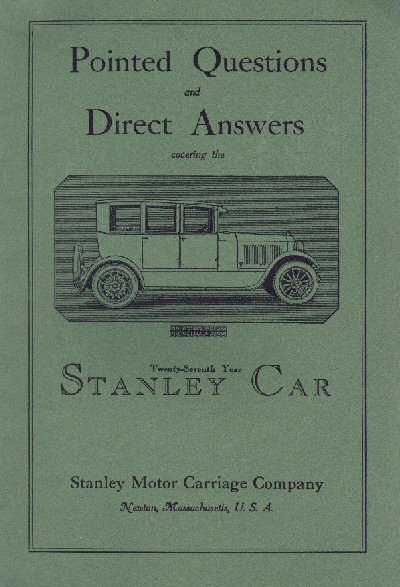

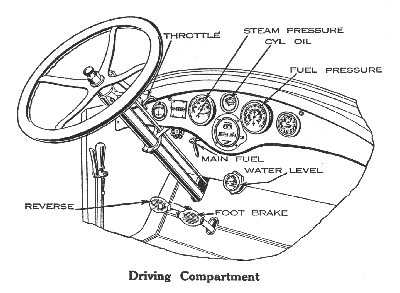 1. With the increasing interest in the new Stanley car,
and its refinements in appearance and general fitness, I feel that I ought to
learn more about it. Will you tell me about it?
1. With the increasing interest in the new Stanley car,
and its refinements in appearance and general fitness, I feel that I ought to
learn more about it. Will you tell me about it?
Gladly.
2. My interest has been definitely growing because of the increasing number of people I know to be of good judgment in motor cars who own Stanleys. I have ridden in their cars often and driven them a little. Now, I should like to learn about the mechanism -- about the principal parts and their functions.
Very well. Let's begin at the front and go right through the chassis.
3. That means with the lamps. How is the electricity supplied?
By a dynamo and battery. Not having to use it for power to start the engine, we are permitted a simple and sturdy installation geared direct to the rear axle.
4. Now we come to the radiator.
Yes; the condenser. This condenses the steam from the engine and returns it as water to the water tank and permits a journey of 150 to 250 miles on one supply, 24 gallons. The tank is refilled through the condenser filler-cap, as in any car.
5. Could a greater mileage be had by using a fan?
Yes; but 150 miles of hard going or 250 of ordinary going means a good day's run -- or a week's run in ordinary use. The simplicity and directness of the steam power plant permit dispensing with the fan along with the gear shift, the clutch, the self starter, etc.
6. What do you do to prevent the condenser's freezing?
Nothing. It doesn't freeze. As the steam condenses back to water, it returns to the tank which is lower than the condenser so that the condenser is empty.
7. May I lift the hood?
Certainly. You will find the boiler there.
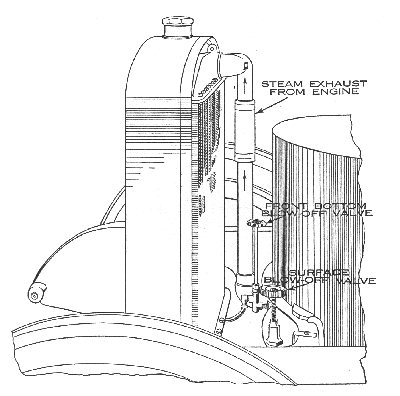 8. Yes, I know; and the sturdy, compact installation I
found under the hood and the absence of moving parts there helped to confirm my
belief in the simplicity of steam for motor cars. How is the boiler constructed?
8. Yes, I know; and the sturdy, compact installation I
found under the hood and the absence of moving parts there helped to confirm my
belief in the simplicity of steam for motor cars. How is the boiler constructed?
It is shaped like a drum and stands on end. Through it run vertical tubes open at each end, so that the heat from the burner passes up through them. The water is within the drum or shell and surrounds the tubes. The strength of the shell which in itself is ample, is multiplied many times by the windings of piano wire, and as piano wire has greater tensile strength than any other form of metal, it is this construction, originally devised by us, which makes the Stanley boiler the most efficient, the lightest, and the most compact boiler in the world. Big cannon have been wire-wound in this same way for years, and for the same object -- to get great strength and efficiency in light weight and compact size.
9. How is the water supplied to the boiler?
The supply from the tank is always greater than is required by the boiler, and is controlled by a self-acting valve. This admits just the right amount to replace that used as steam, and the excess returns to the tank. The water circulation, in fact, is very much like that in first-class internal-explosive cars. We use a plunger pump.
10. How much attention does the driver give to the water, then?
None at all; the valve is self-acting, and responds to the requirements of the boiler without the driver's attention, and in fact, without even his knowledge.
11. How much water does the boiler hold normally when running?
It is about half full. This water, heated to nearly 500 degrees, is the stored power of the Stanley car. It contains enough energy, built up in advance, without adding any more, to drive the car some three or four miles on a good level road. This available energy or stored power is what makes possible the highly important element of control by one throttle. It is what gives you the sense of mastery over the situation when driving a Stanley car. It is one of the factors of the Stanley's matchless performance.
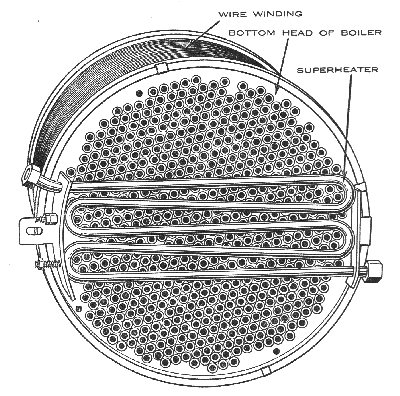 12. Why is it that there is no danger that the boiler
will explode?
12. Why is it that there is no danger that the boiler
will explode?
It is provided with self-acting control valves for fuel and water; and with a safety valve.
13. But what if they should fail to work?
Then it is no exaggeration to say that the boiler itself consists of over 600 safety valves. There are over 600 tubes. Since the shell, with its wire winding, is many times stronger than the tubes, the tubes would yield first and collapse. The weakest one would collapse first and perform the function of a safety valve. To cause an explosion, every one of the tubes would have to go at once; which is just as impossible as to pull a chain with 600 links and make them all break at once.
14. Why is it that Stanley owners never take care to select soft water, and yet are not troubled with sediment?
Because the water returned from the condenser is distilled water, and it is thus used over and over again, so that the sediment is slight. Furthermore, ample provision is made to get rid of it, as the whole area of the boiler is in close proximity to the blow-off valves. In ordinary boilers the area of sediment is too great to be entirely reached.
15. What is the life of the boiler?
Its life is indefinite. It is not subject to frictional wear. Unsatisfactory life is almost invariably found to be caused by gross neglect (such as not keeping it clean, so as to maintain the proper circulation); or by inexcusable abuse (such as attempting to steam it up without any water in it). Even when only partial care is given a boiler, its life is sufficient to vindicate the owner's judgment, in comparison with the best cars on the road, in supplying uninterrupted, comfortable transportation with assurance year in and year out.
16. Now tell me how the water is heated and turned into steam.
This is done by the burner, sealed beneath the boiler. There, the fuel, automatically fed, and vaporized by its own heat, burns in blue compact jets a few inches high. The chamber is entirely enclosed. The heat passes up through the tubes of the boiler, where it is absorbed by the water, thus making the steam. There are two parts to the burner--a miniature burner called the pilot, which burns all the time; and the large part called the main burner, which burns as the road conditions vary the demands upon the boiler for steam.
17. Then the driver does not attend to that?
No. a self-acting valve on the fuel line, set to act at 500 pounds, responds to the pressure in the boiler. When the pressure reaches this point, it shuts off the fuel. It opens again when the pressure recedes a little, and admits just enough kerosene to the burner to replace the steam used. The burner capacity is sufficient for the maximum calls on the boiler, which makes its work light for ordinary conditions.
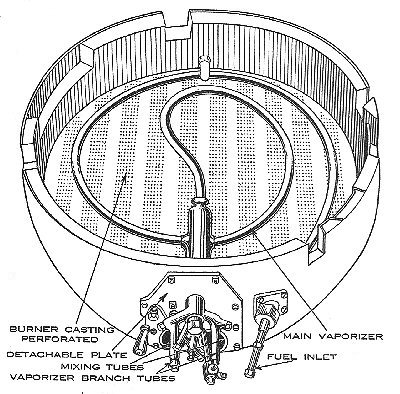 18. When this valve shuts off the main burner entirely,
how is it lighted again ?
18. When this valve shuts off the main burner entirely,
how is it lighted again ?
By the pilot, which is not controlled by this valve, but burns continuously, like the pilot on an ordinary household gas range or automatic water heater; it is this function which gives it its name. It is completely enclosed with the main burner.
19. How does the fuel vaporize in this pilot?
The pilot vaporizer lies right in the heat of the pilot itself. No outside agency is used. The main burner fuel likewise is vaporized by its own heat without the aid of any carburetor, atomizer, or blower. The combustion unit, in fact, is entirely self-contained and independent of variations of temperature or humidity. As gasoline is deteriorating rapidly in volatility and responsiveness, the advantage of vaporizing liquid fuel by heat, instead of relying on the atmosphere, is becoming more and more recognized.
20. Why doesn't a high wind disturb the burner?
Because it is completely enclosed, and the gas goes into the burner at great velocity, so that the highest wind cannot affect it. Few winds are as high as the speed often attained by the car on the open road, and meeting that condition naturally takes care of the other.
21. Does the pilot give enough heat to maintain steam pressure when standing?
Yes; it will respond to the condition at hand, and keep the car ready to go in all kinds of weather.
22. How much pressure is necessary to start the car?
It responds nicely with pressure barely registering on the gauge; but more pressure will give better control.
23. Suppose I leave my car in front of the office for three or four hours, or in front of the theatre during the performance on a cold day.
You will fid enough pressure to start with. And the pilot keeps the main burner hot so it can be turned on at once with assurance, and the pressure will soon build itself up, while running, to the 500 pounds.
24. I can understand how the pilot keeps the boiler warm even in cold weather, but what protection has the water tank against freezing?
The products of combustion from boiler and burner, when standing, are delivered directly against the water tank, which helps it to retain its warmth. Furthermore, after the car has run even a short distance, the water in the tank is warm from the exhaust steam and will resist the cold while standing for a, long time. This is quite enough except in severely cold weather when the car has been left exposed for several hours. Then, some ice may form in the tank.
25. Wouldn't that stop the flow of water into the boiler or injure the tank?
No; because the moment the car is again started, hot water from the condenser flows in and melts the ice. You will observe, also, that the tank is wedge-shaped. Therefore, if the water should freeze solid, the shape would allow for expansion without injury to the tank.
26. When I leave it for the night, should I put out the pilot?
That should be governed by the use required from the car. Leave the pilot going at night and you will have steam enough to start in the morning. Or if you should leave it two or three days you probably would find no pressure, but the water and combustion systems would be hot and in a minute or two you would have pressure enough. In fact, putting out the pilot is only justified when you know in advance that you are going to leave the car for several days. Most Stanley owners leave the pilot going continuously. The factor of flexibility and one hand control, with consequent mastery in any kind of traffic, and the ability to burn low grade fuel with assurance, even in coldest weather, unconsciously tempt the Stanley owner to use his car day in and day out, the year round. However, if not used often enough to justify keeping the pilot going, it is a simple matter to drain thoroughly for storage in a cold garage.
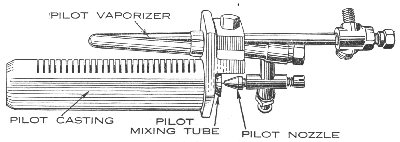 27. How is the car steamed up when left with pilot out?
27. How is the car steamed up when left with pilot out?
It is a simple and positive matter. The initial heat for vaporizing the pilot fuel is applied by pressing an electric button. The pilot then quickly heats the main vaporizer, whereupon the main fuel valve is opened. From ten to twelve minutes should be allowed for steaming up when the car has been left with pilot extinguished.
28. Isn't this ten-minute wait a disadvantage?
It might be so considered if you did not take into account that you are storing up power for instant use in any emergency which may confront you, and that you will not have to shift a gear or throw out a clutch or step on a self-starter, even once, during the day. You have to be patient with your internal explosive engine before you get it started and heated up and working smoothly in cold weather, or when some delicate adjustment becomes disturbed.
But after all, it is a rare thing for a Stanley owner to leave his car with the pilot extinguished. It is almost universal to leave the pilot going unless the operator knows in advance that he is not going to use his car again for some days. Certainly in a year's use, the Stanley will show a lower average of time consumed in starting.
29. How much, fuel does the pilot consume?
About a gallon in twenty-four hours when the car is in daily use; about half that when it is merely used to keep the fuel and water systems hot.
30. Isn't that a waste of fuel?
No; because the heat from it is stored in the boiler, a place not exposed to quick radiation. It is wasted only in the same sense that the fuel is wasted in an internal explosive engine when you run it a while before starting out, to heat up the water and fuel systems; and when you keep "idling" at crossings to insure a prompt start.
31. Have you made provisions for adjustment, as they have in spark-plugs, carburetors, and other devices for burning fuel?
Yes; the pilot is adjustable on the car, or the whole assembly is removable as a single piece. This adjustment is not a matter of elimination or guessing, as you can readily see the nature and results of your work.
32. The pilot seems to be a highly valuable member.
It is. It makes the car independent of weather conditions. Vaporization is by heat supplied by the pilot itself. This results in constant conditions for the combustion system and renders it independent of variations of temperature and humidity. With the pilot burning, no matter how long the car has been standing, the main burner gets hot gas at once, all ready for perfect combustion. The pilot maintains heat in the water system as well. It even keeps the small, tight garage warm. With the assistance of a little simple and positive insulation, which having been done once does not have to be undone or done over again all winter, the pilot prevents freezing indoors or out for any period within the limits of business, pleasure or social use.
33. Is all the main burner fuel under pressure?
No. Only a quart. The kerosene is carried in a tank at the rear of the chassis. It is pumped from this supply tank to a small service tank where it is kept at a constant stabilized pressure. This supplies more kerosene than the burner requires, and the excess is diverted by a self-acting valve back to the main supply tank.
34. What provision has been made for an air chamber in this service tank?
An air storage tank is provided, and opening a valve admits the air to charge the service tank, and then the fuel pump maintains this pressure indefinitely, without further thought. This pressure, of course, is not lost when the supply tank runs empty or even when it is being filled.
 35. Your burner is very simple and direct. Do you have
as much trouble with carbon as in internal explosive cars, where is must be
accepted as a necessary evil?
35. Your burner is very simple and direct. Do you have
as much trouble with carbon as in internal explosive cars, where is must be
accepted as a necessary evil?
There is but little carbon trouble in the Stanley, both because but little is deposited and because it is easily accessible for removal. The Stanley does not follow the method of exploding the fuel in cylinders with rapidly moving parts and with hot flames coming in direct contact with the lubricating oil and leaving a deposit. The fuel in the Stanley is burned by sustained combustion, with no moving parts involved, end so the owner is spared that more serious carbon trouble which follows from intermittent explosive combustion.
36. Is the odor from kerosene fuel any more offensive than from gasoline?
You mean, of course, the odor from the vapor of improperly consumed fuel. Kerosene vapor is less volatile and less pungent than gasoline. Nevertheless, that which causes this also makes it advisable not to slop it about in handling, which its low inflammability permits. It is this odor, not that from combustion, which is objectionable. Combustion itself is more perfectly under the driver's control in the Stanley than in any other car, because of the pilot, which, properly maintained, will insure complete and therefore odorless combustion.
37. Is there any more noticeable heat in rite Stanley?
The heat which propels the car is generated, as in any car, under the hood in front, where it is heavily insulated. There is no more heat than in other cars, and less than in most, especially those in which the exhaust pipes come close up under the body.
38. From the boiler does the steam pass directly to the engine?
Yes; and on its way it passes through the superheater.
39. What is the superheater for?
For economy and for increasing the activity and responsiveness of the car. It is a development which has increased the efficiency of our small, light, compact boiler by adding the greatest energy to the steam after it leaves the throttle on its way to the engine. This added vigor contributes greatly, of course, to the security and mastery in operation. Though simple and obvious now, it was an important achievement when we introduced it. It is one of the decisive factors which make Stanley activity, responsiveness, control and economy so conspicuous and gratifying.
40. Why is the Stanley engine geared direct into the rear axle?
Because that is the ideal application of power, and the simplicity of Stanley design permits it. This feature, indeed, illustrates again the extreme flexibility of steam -- not only in performance but in design.
41. What is the gear ratio of the Stanley?
The ratio is 1-1/2 to 1. With this ratio the car can turn its wheels under all conditions.
42. Why are there only two cylinders in the Stanley engine? Wouldn't it turn more smoothly if there were more than two?
No. The cylinders in the Stanley deliver a continuous flow of power. They are double-acting; that is, they take steam on each stroke in each direction, and the impulses are not explosive but expansive, so that the power follows the entire travel of the pistons. Every stroke is a power stroke; there are no scavenging strokes nor compression strokes -- no idle strokes at all. A larger number of cylinders would be unnecessary -- in fact would be inconceivable -- as the full turning power is delivered by two. Since there is no gear shift or clutch in the Stanley, the engine being constantly in mesh, it follows that there are no interruptions of this continuous flow of power. These factors result in a smoothness of propulsion which is one of the most gratifying characteristics of the Stanley. It is apparent at all speeds and especially at low speeds in heavy going, as in the mud or the snow, or through traffic.
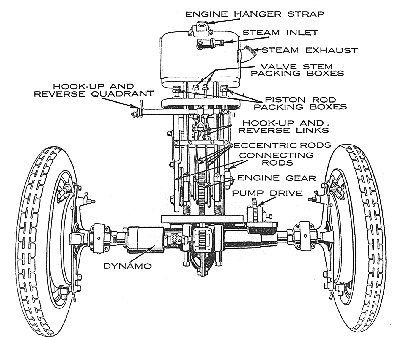 43. Is there any condition where a change of gear would
be advisable?
43. Is there any condition where a change of gear would
be advisable?
No. Gear changes are introduced into an automobile only to get more power out of the engine at low car speeds by increasing the engine speed. But in the Stanley, power does not depend on the speed of the engine. It depends on the pressure exerted on the piston head; and this pressure can be just as great at low engine speed as at high. Hence, far greater power can be delivered than the twenty horse-power rating we give our cars, which represents normal use and is unusually conservative. In fact, the greatest effort can be brought to bear when the car is in an immovable position, as when up against a stone wall.
44. Then that is why I am able, when driving a Stanley, to get all ranges of power by throttle only?
Yes; because the throttle admits just enough steam to the engine to do the work at hand. The throttle of the Stanley renders a greater service than a gear shift, however, since it involves no separation of power from load (which is always undesirable and often dangerous), no jerks or interruption of torque, negligible manipulation, no mental anxiety about the relation of car speed to engine speed, and because the entire power range can be swept through at a single stroke.
45. Increasing the size of the boiler, then, would not increase the pressure available on the piston heads?
No; that would not vary with the size of the boiler. The stored power, however, is to give flexibility to meet all conditions, and for this it is ample. The Stanley boiler is the result of twenty-five years of experience in meeting all motoring requirements, recognizing the necessity and value of supplying power, speed and control which will vindicate the owner's judgment and pride on the road. It meets the extreme conditions when the work is heavy without being wasteful when the work is light.
46. What do you mean, not wasteful when the work is light?
Automobile engines are called upon for light work nearly all the time, but for safety and convenience they must meet momentarily the extreme conditions. This is commonly taken care of by installing engines which are far heavier than is necessary for average use, and which are most efficient only at high speeds, which are seldom permitted by conditions. It is a unique characteristic of steam power plants that they can be throttled down and run continuously at low speeds with the same assurance and economy as at high speeds.
47. How many revolutions per minute does the Stanley engine make?
The Stanley engine has the same number of revolutions per mile (924) no matter what speed or tractive effort it is developing. At 6 miles an hour it is making 92 revolutions per minute; at 15 miles an hour, 231; at 30 miles an hour, 462; at 60 miles an hour, 924, etc. It is always on "high gear" but it is never at high speed. Lubrication difficulties are, therefore, practically unknown.
 48. But some lubrication is necessary?
48. But some lubrication is necessary?
Of course. But the slow speed makes lubrication problems much simpler than in internal explosive cars whose engines, with from two to six times the number of cylinders, revolve at excessive speeds. The cylinders in the Stanley are lubricated by an advanced type of oiler which delivers a definite amount of oil for each revolution of the engine, the steam being impregnated with this oil on its way from the boiler. The bearings, including the differential and the inside rear axle bearings, are lubricated from an entirely independent source, that is, by an oil splash in the crank case.
49. How do you account for the impression, that it requires more mechanical skill to run a Stanley than in internal-explosive car?
Where such prejudice exists, it can come only from not having looked into the subject. Things can be great or small only by comparison. The functions of the Stanley power plant reduce themselves to the simplest character -- boiling water over a kerosene stove and controlling the admission of the resulting steam into a two cylinder engine, the only manual control for running being the throttle itself. The absence of the element of mind in control of the Stanley is one of its greatest comforts. For instance, the driver does not have to use thought or skill in "selecting" his "speed," for the throttle is always placed by him unconsciously at the point best suited for the work of the moment.
50. Is there any special requirement in any locality for operation or registration of the Stanley?
No. The requirements for both types of cars are the same everywhere.
51. How do you reverse the car?
This is done by a pedal at the left foot of the driver. There is no gear shift involved. This pedal merely changes the position of the slide valves in the engine, which causes the engine to reverse. as another example of the responsiveness and flexibility of the Stanley, the car has the same power and control backward as forward.
52. Can the engine be used as a brake?
Yes; it is common practice to use it in reverse as an extra brake, to ease the car down long grades; or, as an emergency brake, it is doubtless the most effective in the world. The Stanley engine develops compression only when reversed for braking; this resistance does not exist at any other time.
53. Can my wife drive this oar?
Yes; she can drive it with less physical effort and less mental anxiety than any other car. Not only that, but there will be no embarrassment from torn shoes and gloves resulting from clutching and gear shifting. In addition, you will find that when she is on the road with the car, you yourself are not nervous lest she stall the motor; she has stored power at her command with only the throttle to operate, and this gives her a sense of complete mastery. She has the same control and security which make the electric the accepted lady's car, and vastly greater power, responsiveness and radius of action.
54. The Stanley is so easy to drive, I should think they would be often stolen.
This might be true except that cars of high character and moderate production are easily traced and, therefore, seldom stolen, a fact reflected in the insurance rates. Likewise the collision hazard is low, because the flexibility and control, and the impossibility of stalling the engine, enable the operator to keep out of accidents. This applies with equal force to the liability hazard.
55. What about fire insurance?
The Stanley is rated in class "D," in which one-third or more of the automobiles are placed by the underwriters. an interesting aspect of the insurance is that the fuel of the Stanley, kerosene, can be stored in your garage or home without increasing the storage rate.
56. What mileage can you get to a gallon of fuel?
You can count on an all-the-year-round average of about 12 miles per gallon of kerosene. In city traffic or hard and hilly going, it will be somewhat less than that; in straight-away cross-country running on fairly good roads, it will average 14 miles or upwards.
57. Suppose I can't always get a supply of kerosene? What then?
Use gasoline or any mixture of kerosene and gasoline. There are no adjustments to make.
58. How do you account for the quality of easy riding, for which the Stanley has such a universal reputation?
Many reasons contribute to this. Most important is the inherent flexibility of steam, which eliminates vibration and self-destructive effort, and permits positive control by throttle only, and enables the operator to do the right thing, instead of having to do what the engine compels. Of other causes, well-distributed weight and low center of gravity are most important, and in these the Stanley has the advantage of the flexibility of steam car design. The boiler at the front, the engine carried on the chassis-frame and geared into the rear axle, all contribute to this, and of course, assure correct spring suspension. The flexibility of steam car design is reflected even in the comfort of the seats, especially of the driving position which is designed without the limiting factors of gear shift lever, clutch pedal, etc.
59. I have been told that the Stanley has an unusually long life.
There are sound reasons for that. Cars are worn out more from abuse than from use, and the Stanley offers less opportunity for abuse. Its engine moves slowly, without vibration or self-destructive effort; there is no necessity, nor even any means, for racing it; it is not used as a fire box and its lubrication is direct and positive. The fuel is consumed in a motionless process without contaminating the lubrication. Steam generation is also a motionless process, and the boiler is not subject to frictional wear. By its flexible control the whole car, and its occupants as well, are spared the abuses and shocks which follow when a less flexible object meets an inflexible condition. Furthermore, the new Stanley represents twenty-five years of earnest effort in one direction by one organization in one place, benefiting from this long experience in the selection of the materials best suited for the service required, and from the advantage of traditional New England workmanship. Such factors, building on the foundation of a power plant which was already standardized and established, result in a harmony and regularity of behavior which mean long life. The proof of this is best found, perhaps, in the high used-car value the Stanley commands.
60. Do you give the standard automobile ninety-day guarantee?
Yes. And in addition you need the guarantee that comes from making an article of merit a sufficient length of time to establish confidence.
61. What if I should buy a Stanley now and next year come to sell it out right or trade it in for a new one?
Stanley cars unquestionably bring more money when sold at second hand than any other car. There are two causes for this; first, the intrinsic merit of the Stanley; and second, a less competitive market.
62. You spoke of abuse. The worst kind of abuse to any car is the kind done by mechanics unaccustomed to it. How does the Stanley owner get service away from home?
As with any other car. The best motorists realize that they can achieve first-class satisfaction and drive with assurance only when they buy cars of established reputation and understand them sufficiently to anticipate trouble by accurate diagnosis. Otherwise, they will make many trips to the service station merely to find out what is the matter. The functions and functional parts of the Stanley are more obvious and direct, and more easily comprehended than any other car. The result is that at home the owner finds that he himself or some one in his employ can mage all necessary adjustments, and on tours he can direct them with assurance wherever ordinary intelligence is to be found.
63. Is there any inconvenience about storing a Stanley in a public garage?
There are sound reasons which should make the Stanley a welcome guest in garages generally. The new refinements and character of appearance, the acknowledged silence and dignity of its behavior, such improvements as the condenser and the pilot lighting switch -- these factors, coupled with kerosene fuel, equal insurance rates, perfect control, and the confidence with which the owner proceeds, have eliminated much of the prejudice which previously existed, inherited from a former steam car with a pilot exposed outside the burner and underneath the body. The average garage keeper, with a favorable opportunity to compare all kinds of cars and their upkeep, recognizes quickly the merit of the Stanley.
64. Why are there so few steam cars made?
This is due, undoubtedly to the momentum of precedent -- to the very fact that most cars are internal explosive cars. The public, knowing little about the relative merits of the two types, assumes that the internal explosive type is better because that is the bind the manufacturers make. The manufacturers, assuming from this that the public is demanding internal explosive cars, continue to supply that type; and the demand for automobiles has been so great that the manufacturers have so far lacked the incentive to find a means to supply the qualities which are better suited to the public's needs -- the qualities of true flexibility and control -- the ability to meet the extreme conditions of traffic, acceleration, temperature, fuel load, road and speed.
This same state of supply and demand has, indeed, retarded the expansion of the steam car industry. The Stanley has been its one representative, and its demand has far exceeded its output. Its makers, therefore, intent upon its superior performance, for years ignored all incentive to clothe this performance in an exterior of which it was worthy or which conformed to the prevailing fashion.
Nevertheless, the Stanley continued to enjoy an unequalled record of repeat customers. The public at large, however, soon came to the notion that steam cars looked old because they must, which misapprehension, we believe, stultified their popularity. Manufacturers in turn, sensing but misinterpreting this lack of popularity, considered it advantageous to offer internal explosive cars. The new Stanley, however, is without this serious limitation, and in appearance it is distinguished only as other cars of the highest grade are distinguished, by character of line and refinement of detail and finish.
In addition to these causes the steam car industry has suffered because of many unworthy stock promotions in recent years appealing to the public's instinctive recognition of the superiority of steam for automobiles. These have featured coil boilers, spray or atomizing burners, and other departures with alluring names but little likelihood of ever getting into production.
65. What does the Stanley weigh?
The seven passenger open car weighs 3,825 pounds. It is the balanced distribution of this weight which gives to Stanley owners the unmatched riding comfort plus extraordinary economy of fuel and tires.
66. What is the price of the Stanley?
The price of the seven passenger open car is $2,750 f. o. b., Newton, Mass. The prices of the five passenger phaeton and the two passenger roadster are likewise $2,750. The five passenger sedan is $3,585, and the seven passenger sedan is $3,985.
67. With its simplicity of construction, the Stanley seems relatively high priced.
Character cars always seem relatively high-priced; but when a character car goes into quantity production, though its cost may seem lower, it invariably loses much of its refinement and advantage. Sales overtop everything, and prompt and adequate service becomes more and more difficult. Comfort in transportation, the demand for which creates character cars, means not only physical comfort, but also comfort of mind -- the knowledge that your good judgment as a motorist will be recognized -- that service can be directed wherever ordinary intelligence is available, that the manufacturers will continue in business. The Stanley gives the additional comfort that this satisfaction is purchased at a reasonable price; that there will be no severe competition at second-hand sale; that its power plant is fundamentally correct so that no radical model next year will render this year's car out of date; that no self-destructive effort will make continued ownership prohibitive in cost or inadvisable in comfort; that the car can burn next year's fuel as well as this year's. By virtue of its inherent characteristics, it retains its youth and worth.
68. Nevertheless, your car has improved mechanically in recent years as well as in appearance, has it not?
Yes; we are constantly making improvements in mechanical matters, in power, in conveniences and in general fitness. Our new model, the 740, for instance, has a boiler18 inches high instead of 14, as formerly, which gives it 50% greater power storage, and 30% greater heating surface. Cylinder lubrication has been greatly improved. The rear axle is sturdier and simpler, with larger bearings. The brakes are improved and simplified with better adjustment, and increased 600% in friction surface. Chassis oiling is easier with a patented system of oil cups and gun for quick and efficient filling. In addition the car is built closer to the ground with more graceful fenders, and 32 x 4-1/2 wheels. It has a lower-set top which is lined and has a permanent firm member from windshield to rear bow. It permits the quick installation, without alterations, of our advanced type of winter enclosure with large glass windows, which we supply in addition to the summer curtains, at a small additional cost.
69. I have made up my mind that my next car will be a sedan. Are the Stanley qualities suitable for a closed body?
Yes; closed cars form an increasing proportion of our output, not merely because of the general recognition of this type for all-the-year-round comfort, but especially because the Stanley is supremely adapted to it. Closed bodies of first-class design, material and workmanship, with the virtues that long experience built into them, will stay sound and fit if there is no vibration, no clutching, no self-destructive effort to make them rattle before their time -- a fact which justifies and encourages the pride and care we take in making them. And consider the passengers, also, and the comfort they get from the smooth, restful, gliding motion of the Stanley, from the silence and harmony, from the absence of harsh, mechanical forces at work, and from the assurance that they can keep their rightful place in the traffic. They share, too, that feeling of mastery and security, so doubly essential in closed cars with which Stanley stored power and flexibility equip the driver. We anticipate, also, the demand for a car which shall be open in summer and tight and comfortable in winter by offering storm-proof equipment for touring car tops which gives the protection and vision of closed cars, and which is light, inexpensive and quickly changed.
70. Your information fortifies me for talking with other motorists and with dealers who seem to be surprisingly misinformed about the Stanley. How do you account for this?
The fault is undoubtedly ours, since there has been no broadcast information about our product but only that given by our customers, most of whom feel that their own repeat orders are sufficient evidence of their satisfaction. Nevertheless, the best dealers and the best motorists, like yourself, are rapidly recognizing that the steam power plant is best suited for a variable-speed, variable-power vehicle.
71. What do you mean by a variable-speed, variable-power vehicle?
The conditions under which an automobile must be operated call for an extremely wide range of power and speed. In fact, no other service requires such variability. No other power plant requires such alert operation for the safety of operator and public, and no other power plant is so universally put into unskilled hands. It seems essential, then, that the one which is not only endowed by nature with the characteristics necessary for a variable-speed, variable-power device, but which is also simplest in its functions and mechanisms and most easily comprehended, should be used in the automobile.
Only in the steam power plant can power be stored and replenished as used. It is this stored power, built up in advance and ready for instant application, which gives to Stanley cars true flexibility and true responsiveness to variable requirements. It is stored power which permits gearing the engine permanently to the rear axle, control by throttle only, and emancipation from gear-shift, from clutch and from consciousness of engine speed. It is stored power which gives to Stanley cars that quality which motorists have always longed far -- maximum power at lowest car speeds.
POWER
Correctly Generated
Correctly Controlled
Correctly Applied
to the
Rear Wheels